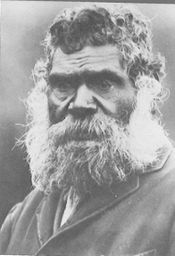Poltpalingada Booboorowie facts for kids
Quick facts for kids
Poltpalingada Booboorowie
|
|
|---|---|
 |
|
| Born | circa 1830 Lake Albert, South Australia
|
| Died | 4 July 1901 (aged 70–71) Adelaide, South Australia
|
| Other names | Tommy Walker |
| Known for | Prominent Fringe dweller in Adelaide, South Australia during the 1890s |
Poltpalingada Booboorowie (born around 1830 – died 4 July 1901) was a well-known Aboriginal man from the Thooree clan of the Ngarrindjeri nation. He lived near the city of Adelaide, South Australia, in the 1890s. Many people in Adelaide knew him as Tommy Walker. He was a popular figure, and stories about him often appeared in newspapers.
After he passed away, his body became part of a sad story. It was found that the city's coroner, William Ramsay Smith, had taken his remains before burial. He sent them to the University of Edinburgh for study as an anthropological specimen.
Contents
Poltpalingada Booboorowie: A Famous Figure
Poltpalingada Booboorowie, also known as Tommy Walker, was a very popular person in Adelaide during the late 1800s. He was known for his quick wit and entertaining ways. People loved to hear his stories and see him perform.
His Early Life and Travels
Tommy Walker was born in the early 1800s near Lake Albert in South Australia. When he was young, his father was reportedly killed in a fight with the nearby Kaurna people.
Tommy often worked for local settlers. He might have even traveled to the Victorian gold rush in the 1850s. For most of his life, he moved between camps where Aboriginal people lived. Even though he preferred to live away from white settlements, he often visited the Point McLeay Mission (Raukkan). This mission was located on the banks of Lake Alexandrina.
Tommy was known for his humor at Point McLeay. He was often arrested for minor public disturbances. One famous story tells of him at church. When the communion cup was passed to him, he would drink it all. Then he would call out, "Fill 'im up again!" From the 1870s, he was always seen with his companion, Mary.
Becoming Famous in Adelaide
In the late 1880s, Tommy Walker and Mary moved to the Adelaide Park Lands. They joined other Aboriginal people living there. Mary passed away in 1892, and Ada Niledalli became his new companion.
Photographs show Tommy as a strong man with bushy hair and a full white beard. He often wore a ragged jacket or a tail-coat and a grey felt top hat. He was usually barefoot.
His Unique Style and Wit
Tommy was a talented mimic and had a "sharp wit." He spoke English very well. Newspapers called him the "chartered libertine of the metropolis" because he was so free-spirited. His popularity was so great that the government gave him a pass for free travel on public transport.
He was also very good at quick comebacks. One story tells of him traveling in a first-class train carriage. A government minister asked him, "Hello Tommy, how do you come here?" Tommy immediately replied, "All the same as bloody member of Parliament, got a free pass."
Public Performances and Popularity
Local newspapers regularly wrote about Tommy's activities and his many court appearances. They sometimes used unkind language, but people loved him. Tommy's way of asking for money was like street theatre. He would act out his recent arrests, pretending to be both the judge and himself.
Aboriginal people could attend public events for free. So, Tommy often went to football and cricket matches at Adelaide Oval. There, he would entertain the crowd by acting out his court scenes. He would play both the judge and the person on trial.
Tommy became a common sight in Adelaide. He would walk the streets with Ada and his dogs, often followed by dozens of children. He once told a reporter, "It's a funny thing that a gentleman can't walk along the footpath without a crowd of kids after him."
His frequent arrests were so well-known that a rhyme about him became popular among school children:
Tommy Walker, walk up here
You are charged with drinking beer
Forty bob you'll have to pay
Or down below you'll have to stay
Ta-ra-ra-ra-boom-de-ay.
Tommy saw this song as a compliment and often sang it himself at public gatherings. Any money he owed was always paid by public donations or from the money he earned from his performances.
Portraits of Tommy Walker
Poltpalingada Booboorowie was the subject of several paintings by the Adelaide artist Oscar Friström. One of these paintings was bought by Sir Edwin Smith for the National Gallery of South Australia in 1894.
His Final Days
In July 1901, the Duke of Cornwall (who would later become King George V) was set to visit Adelaide. By official order, Adelaide's Aboriginal people were moved to Encounter Bay, about 100 km (62 mi) south of Adelaide.
Wanting to see the Duke, Tommy and several other Aboriginal people walked back to Adelaide. Tommy was found to be "weak and feeble" due to the cold weather. He was taken to the Adelaide Hospital but left on June 28. He returned to his wurlie (a traditional shelter) in the parklands. He was later taken back to the hospital, where he passed away from hypothermia on July 4.
The Adelaide Stock Exchange paid for his headstone. Tommy Walker was buried in the West Terrace Cemetery.

